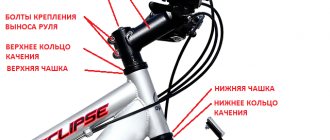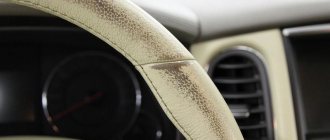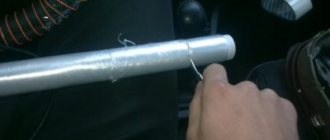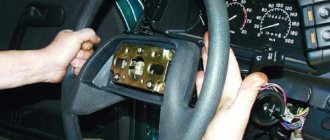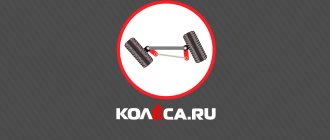Many car enthusiasts are interested in how to make a multifunction steering wheel with their own hands. After all, this option is missing on almost all old cars and even on new budget foreign cars. But this is a very convenient steering wheel option. Many people do not quite understand what it is and why it is needed. First, let's try to understand this issue. In fact, the multifunction steering wheel differs from the usual one in the presence of buttons to control various additional systems.
Most often, it controls multimedia systems, as well as climate control. Sometimes you can find other layout options.
Varieties
How to make a multifunction steering wheel with your own hands? To answer this question, you must first understand what type of rudders these are. In fact, there are only two main varieties:
- The buttons are located in the rim;
- The buttons are located in the center.
These are the main layout options. To choose a specific method, you need to take into account your preferences, as well as the availability of a suitable steering wheel for the conversion. Also immediately imagine what you would like to connect to such control. Please note that the more devices you connect to the steering wheel, the more difficult it will be to make a normal control panel.
How to connect to the “Lux” package
Connecting the multifunction steering wheel in the luxury version of Vesta is more convenient. This configuration is distinguished by the presence of gray wires in the existing wiring harnesses.
The steering wheel of the Lada Vesta is secured with great force, so it is recommended to remove it by rocking it to the sides, being careful.
The cochlea is connected in the following order:
- There are special holes on the sides of the steering wheel. Insert the rods into them and press.
- In this case, the airbag unit should rise. Pull it out, being careful not to damage the elements of the block.
- Disconnect all wires and remove the steering wheel. To do this, unscrew the central bolt and pull the steering wheel towards you. When pulling out the steering wheel, make sure that the wires pass through the hub hole and are not damaged.
- Installation is carried out in the reverse order of operations.
Control panel in the center
The steering wheel with the control panel in the center of the steering wheel looks the most advantageous. This is the most convenient layout, both in terms of appearance and ease of control. To do this, you will have to choose a steering wheel whose rim size is comparable to the standard one installed on your car. The steering wheel you want to install must have a splined steering wheel with a standard control panel.
This modification is carried out as follows:
- A panel with slots is cut out of the original steering wheel, this is done using an ordinary grinder;
- The same procedure is performed with the steering wheel selected for replacement;
- The spline from the original steering wheel is installed into the new one. Most likely, you will have an erotic task of adjusting the plate and securing it;
- Most often, standard multifunction steering wheels have an airbag. But most likely after the adjustments you will not be able to install it in place. Therefore, you will have to make a piece of foam plastic instead and put it in a suitable size. Poxipol
glue can be used as a sealant around the edges ; - After this, the newly made central panel is covered with automotive putty and also covered with leather.
This completes the housing manufacturing stage. You can use any leather you like. Instead of polystyrene foam, you can use specially prepared polyurethane foam. The signal connection method depends on your model.
What is the correct hand position on the steering wheel?
Even experienced drivers who have serious driving experience and a decent amount of experience do not always know what position of their hands on the steering wheel is considered optimal. It seems like it's a matter of preference, but in an extreme situation, your grip on the steering wheel can make all the difference and even save your life. The placement of hands on the steering wheel affects the reaction speed, as well as the accuracy of the maneuver performed, on which the safety of the driver and passengers directly depends.
They teach at school
Driving instructors agree with each other regarding the position of hands on the steering wheel. The steering wheel should be imagined as a dial and your hands should be positioned like the hands of a watch. The left one is from 9.00 to 10.30, and the right one is from 13.30 to 15.00, respectively. Thus, the hands lie horizontally at the same level, but slightly above the middle of the steering wheel itself. Another important condition is to bend both arms at the elbows - this will also help increase reaction speed and better feel the road.
Common Mistakes
You can often find drivers with more than several years of experience and serious driving experience using their own control methods and the placement of their hands on the steering wheel, among other things. For example, some people practice placing their hands on top, explaining this by reducing the load on the muscles, which of course is not true. With this arrangement of hands, the speed and accuracy of car control significantly decreases.
The opposite is the position of the hands below the average horizontal level. This makes it possible to turn the steering wheel at a large angle in one step without intercepting. This is an imaginary convenience. In fact, the maneuver at this moment is controlled with only one hand, which is dangerous even in the case of such driving when trying to prevent an accident. Driving like this in everyday life can end badly - you will not be able to control the car at a sufficient level with your hands on the steering wheel this way.
Placing your hands diagonally will also cause a lot of inconvenience. This way the angle of rotation will be reduced to a minimum, and the hand located below will always interfere.
Driving with one hand is also not safe. This is only permissible in a situation where it is necessary to change gear or perform another necessary action, but only as a temporary measure, and not as a driving style as a whole.
Fully releasing the steering wheel when completing a turn to return it to its original position is very convenient, but is strongly not recommended. Even if only for a short period of time, you still completely lose control, which should be avoided for safety reasons.
Handlebar grip
Having discussed the position of the hands, it is necessary to clarify the importance of the method of gripping the steering wheel itself. There are three types: closed grip, partial grip and open grip. The safest is a closed one - in this case, the thumb closes with the index finger, thereby pinching the steering wheel between them, thus, the hand grips the steering wheel and provides maximum steering control. In this position, even with a minimal impact, a noticeable pain in the thumb forces you to squeeze it harder, gripping the steering wheel more and more tightly. This rule applies when driving more calmly. When it comes to the highway and high speeds, it is better to choose a partial grip, in which the thumbs rest on the steering wheel, allowing for greater contact and increased steering precision.
Grip strength is also important. With an overly strengthened grip, which will require more energy, fatigue and overstrain in the muscles will occur earlier and the overall quality of control will decrease.
Importance and techniques of taxiing
There are specific steering methods, such as search, tempo or counterbalance, and even pendulum, but these subtleties are only important for professional racers. Despite this, understanding and using the basics of steering is essentially necessary for everyone who gets behind the wheel.
The very first rule of taxiing can be formulated as follows: “You should only steer on good sections of the road.” When you are driving on a difficult road with a significant number of potholes or other irregularities, you need to keep the wheels as straight as possible.
Another important nuance is which hand should be used to turn. Ideally, the hands should not change position until they cross. After this, the lower hand intercepts the steering wheel in the upper part - this is the safest and most effective method.
In conclusion, I would like to once again note the importance of correct interaction between the driver and the steering wheel. The safety of passengers, yourself and other road users is directly in your hands. Don't let your guard down and take the easy road!
Electronic filling
Many people find it difficult to connect the radio to the steering wheel. There's really nothing difficult here. It is enough to take a regular radio with a remote control. This same remote control needs to be disassembled and attached to the steering wheel buttons. In this case, the wiring in it needs to be completely redone. New wiring is done using thin wire. You also need to carefully attach the remote control on the back side.
For more reliable operation, the number of IR diodes is increased to 4-5. They are placed evenly around the entire perimeter of the steering wheel. This modification allows for reliable operation of the multi-steering wheel system in any position. The button illumination can be connected to the signal power supply; this is not difficult to do.
Elbows
Man is a creature guided by instincts. In emergency situations, when adrenaline is pumping, you act to the best of your knowledge and instincts. Therefore, very often in the photo you can see how inexperienced riders riding down a slope press their elbows to their sides. This is a natural defensive reaction; a person tries to group as much as possible and take a protective fetal position. But this plays a cruel joke on the rider himself, because in such a position it is almost impossible to effectively absorb a blow from a stone or after a take-off. Never drop your elbows!
But in this photo of Aaron Gwin (five-time World Cup winner in downhill, eight-time US national champion) you can clearly see how to hold your elbows. This landing is as stable as possible and allows you to effectively absorb shock.
Buttons in the rim
More precisely, they are located not in the rim, but on the transverse bar. This installation is convenient because there is no need to reach for buttons. This can be done even on a standard steering wheel; you do not have to remove it to install this modification. This work is done as follows:
- The radio control panel is disassembled. This is done carefully, do not damage the board;
- Holes for buttons are cut in the steering wheel trim. They can be taken from the same remote control, or from an old music center;
- It is better to place stickers on the overlay that match the color of the buttons, so everything looks much nicer;
- The buttons are connected to a board, which is attached to the cover plate with glue. Do not forget about the need to place a battery next to the board;
- There are 4 diodes placed along the rim of the steering wheel, which are also connected to the board;
- The cover plate is installed in place and the entire structure is tested. If everything was done carefully, then no problems should arise.
Brake lever position
The angle of the brake levers is also important. If you're a flat rider or like to ride uphills with your weight shifting forward, you may be better off leaning your handlebars forward. And if you prefer descents and often move backwards, then tilting the handles too much forward can interfere with you, because you will have to reach for the brake levers. As a starting point, try using the handle at a 45° angle to the plane.
Do not forget that you need to brake with one index finger, or at least the index and middle fingers, and the remaining fingers should not fall under the brake lever.
The thickness of the grip is also a purely individual thing. However, the thicker the grip, the larger your fingers will need to be to grip it, so keep this in mind.
Types of VW Jetta multifunction steering wheel
Today, the manufacturer Volkswagen and other companies that produce original products for VW Jetta cars are ready to offer three types of multifunction steering wheels for purchase and installation:
- Budget class is the most inexpensive steering wheel, which is installed mainly on economy class cars. It has only one button, designed to control the MP3 system. Of course, one function is not enough. They are made from inexpensive material.
- Middle class - installed on mid-level cars. This steering wheel is equipped with many more functions, such as control of the on-board computer, telephone, stability control, speed control, music, and in addition there is a Bluetooth button. They are covered with the highest quality leather. Since the leather itself is poorly processed, the product will quickly become unusable, which is unacceptable for a premium sedan.
- Top class - the name speaks for itself, this steering wheel has many functions to make the driver comfortable while driving. The steering wheel has functions such as speed control, Bluetooth, control of the on-board computer, side mirrors, suspension and many others. Some have seat heating controls. These steering wheels are covered in high quality leather and have wood inserts. Naturally, high-end R-Line is installed on expensive and luxury cars.
However, if you are a sophisticated car enthusiast and want to transform your car from the inside, then the R-Line leather version is what you need . Next, we will look at what types of leather steering wheels there are.
Pros and cons of multifunction steering wheel
Positive effects from using the multifunction steering wheel:
- centralizing the driver's attention to the main viewing area. This effect is not achieved immediately after changing to the multifunction steering wheel. Initially, such a steering wheel even has a negative effect: reconfiguring the focus of vision from distant objects to near objects (buttons) takes longer than diverting the gaze, especially for people with vision problems;
- smaller motor processes in the arms. Most often, movements of the hands or phalanges of the fingers are required to control;
- high speed control of vehicle systems functions. This effect is achieved by the combination of the previous points.
Negative points:
- low reliability. Steering wheel control requires a wired or wireless data link. Control by wire uses a steering column cable. This is a relatively unreliable element and often fails. In addition, the block of buttons and electronic signal conversion located on the steering wheel is in continuous rotation during operation, which further reduces its service life. Almost all controls on the steering wheel are necessarily duplicated in the cabin, so that system control functions do not become unavailable if the multifunction steering wheel fails;
- The steering wheel is movable while driving, as are the buttons on it. Thus, the buttons “wander around the cabin” geographically. This makes it difficult to manage;
- Control of functions from the steering wheel is impossible for the passenger. Often the driver asks for help in driving, for example, searching for a melody or channel, or a passenger. The passenger cannot help do this on the multifunction steering wheel;
- When the airbag is deployed, the functions of the multi-steering wheel are often damaged.

